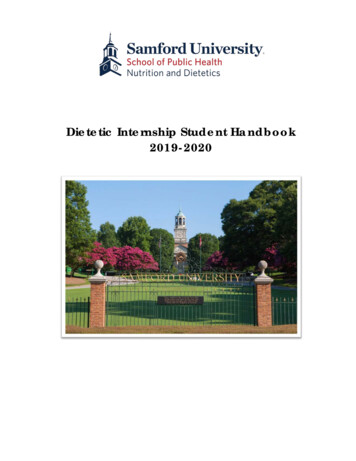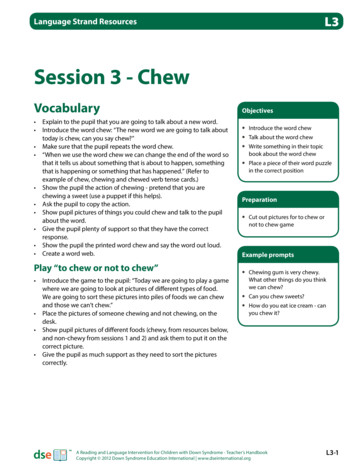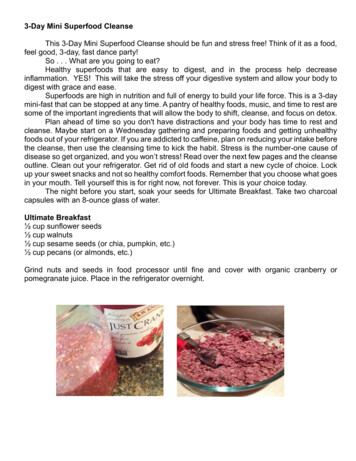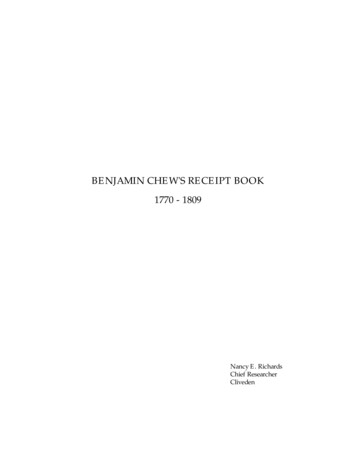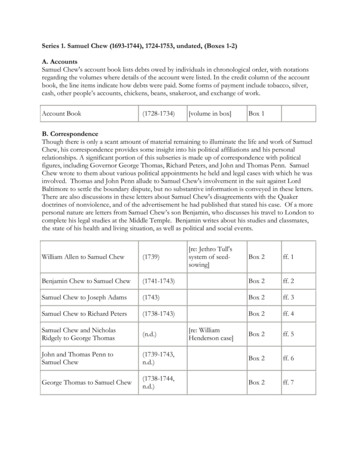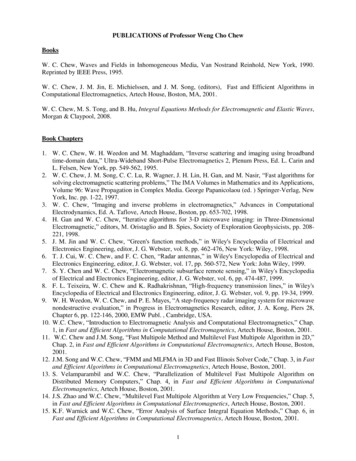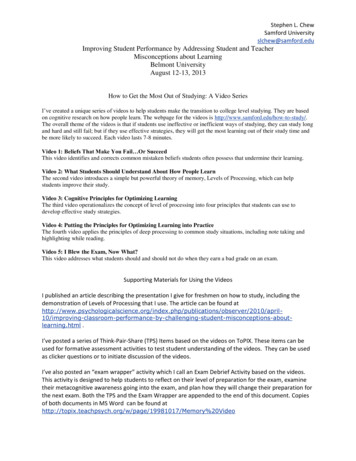
Transcription
Stephen L. ChewSamford Universityslchew@samford.eduImproving Student Performance by Addressing Student and TeacherMisconceptions about LearningBelmont UniversityAugust 12-13, 2013How to Get the Most Out of Studying: A Video SeriesI’ve created a unique series of videos to help students make the transition to college level studying. They are basedon cognitive research on how people learn. The webpage for the videos is http://www.samford.edu/how-to-study/.The overall theme of the videos is that if students use ineffective or inefficient ways of studying, they can study longand hard and still fail; but if they use effective strategies, they will get the most learning out of their study time andbe more likely to succeed. Each video lasts 7-8 minutes.Video 1: Beliefs That Make You Fail Or SucceedThis video identifies and corrects common mistaken beliefs students often possess that undermine their learning.Video 2: What Students Should Understand About How People LearnThe second video introduces a simple but powerful theory of memory, Levels of Processing, which can helpstudents improve their study.Video 3: Cognitive Principles for Optimizing LearningThe third video operationalizes the concept of level of processing into four principles that students can use todevelop effective study strategies.Video 4: Putting the Principles for Optimizing Learning into PracticeThe fourth video applies the principles of deep processing to common study situations, including note taking andhighlighting while reading.Video 5: I Blew the Exam, Now What?This video addresses what students should and should not do when they earn a bad grade on an exam.Supporting Materials for Using the VideosI published an article describing the presentation I give for freshmen on how to study, including thedemonstration of Levels of Processing that I use. The article can be found ns-aboutlearning.html .I’ve posted a series of Think-Pair-Share (TPS) Items based on the videos on ToPIX. These items can beused for formative assessment activities to test student understanding of the videos. They can be usedas clicker questions or to initiate discussion of the videos.I’ve also posted an “exam wrapper” activity which I call an Exam Debrief Activity based on the videos.This activity is designed to help students to reflect on their level of preparation for the exam, examinetheir metacognitive awareness going into the exam, and plan how they will change their preparation forthe next exam. Both the TPS and the Exam Wrapper are appended to the end of this document. Copiesof both documents in MS Word can be found ry%20Video
Stephen L. ChewSamford Universityslchew@samford.eduA video of a similar presentation I gave (for NAC&U) on the development of the presentation forfreshmen as well as the video series and more on cognition and instruction can be found at:http://www.youtube.com/watch?v RgPE1Xc0YisFor Further ReadingCognition and InstructionDaniel Willingham Science and Education Resources and Blog: Daniel Willingham is a cognitiveneuroscientist who maintains a website on current research applied to education. While the focus is onK-12, there is much that applies to higher education as well. He has two books out, but you can learn alot just by reading the resources here, especially his blog. http://www.danielwillingham.com/index.htmlThe best summary of cognitive research applied to teaching is:Ambrose, S. A., Bridges, M. W., DiPietro, M., Lovett, M. C., Norman M. K. (2010). How Learning Works:Seven Research-Based Principles for Smart Teaching. San Francisco, CA: Jossey-BassThe Center for Psychology in Schools and Education (CPSE; part of the American PsychologicalAssociation) has published a really useful set of online modules on psychology applied to educationalpractice. They are called The Teaching Modules (Application of Psychological Science to Teaching andLearning). From the description from CPSE: “An APA task force identified the psychological sciencebehind ten areas of teacher practice and has developed an online module for each topic that includes:An Overview of the Topic, Do’s and Don’ts, Evidence and Explanation, FAQ’s, For Whom Do theInterventions Work, and Resources for Additional Information.” The modules can be found on theCurricular Resources page at als.aspxMental Mindset and Education:Carol Dweck conducted the groundbreaking work on mental mindset, such as beliefs about fixed versusfluid intelligence, affects academic success. There is plenty about her work on the Internet. She has abook out that is not specifically about teaching, but teachers still find it very useful. Mindset: The NewPsychology of Success. Ballantine Books, 2007.The Office of Educational Technology has a draft report available on promoting grit, tenacity andperseverance in students. It focuses on K-12, but once again much of it is relevant to higher education,and it is free. Here is the link (or you can Google “promoting s/2013/02/OET-Draft-Grit-Report-2-17-13.pdfHere are two reports on self-regulation and education that cover the research area. There are lots ofbooks on this topic, but I don’t know how good they e/selfregulation/printversion.pdf
Stephen L. ChewSamford Universityslchew@samford.eduMiscommunication and conflicting expectations between teacher and student can undermineinstruction even when both the student and teacher are motivated to succeed. Cox makes this point inher book: Cox R. D. (2011). The College Fear Factor: How Students and Professors Misunderstand OneAnother. Harvard University Press.Formative AssessmentThe class reference on formative assessment is Angelo, T. A., & Cross, K. P. (1993). Classroomassessment techniques: A handbook for college teachers (2nd ed.). San Francisco, CA: Jossey-Bass.There are many good resources on formative assessment both online and in published books. Here isone book I have seen that is geared to K-12 but is also applicable to college level teaching.Making Thinking Visible: How to Promote Engagement, Understanding, and Independence for AllLearners. Ron Ritchhart, Mark Church, Karin Morrison. Jossey-Bass, 2011.
Stephen L. ChewSamford Universityslchew@samford.eduAppendix 1Think-Pair-Share Activities for Videos on How to StudyNote for InstructorsIn August 2011, I posted a series of brief videos on YouTube about how to study effectively in college.They can be found at www.samford.edu/how-to-study. From my own experience and feedback fromteachers and students, it quickly became clear that many students, especially the ones who most needhelp with study skills, require some kind of scaffolding activities to help them understand and utilize theinformation in the videos. They really weren't grasping it by just viewing the videos. I decided to create aset of Think-Pair-Share questions based on the videos that instructors can use to promote discussion ofthe information. I know other faculty have also developed activities using the videos. I welcomefeedback about these activities and any suggestions for modifications, additions and other kinds ofactivities.These are Think-Pair-Share questions. The item is presented to the class. First, each student should thinkof their answer to the question and be prepared to explain their reasoning. Next, students pair up anddiscuss why they chose respective answers and not others. Finally, the class discusses the question andpossible answers as a whole. The teacher reveals and explains the answer.Some of these questions overlap. Instructors should select the ones they think will be most useful. Thesequestions can be easily modified to be used as quiz or “clicker” questions.Video 1:1.Which of the following statements does NOT reflect a mistaken belief about learning that canundermine learning?a) I plan my study so that I finish reading all the assigned material the night before the exam.b) I won’t do well in my science class because I’m just not good at science.c) I write out the definitions of key terms on note cards and memorize them.d) I keep my phone and computer on while I study so I don’t miss any texts or updates from myfriends.2.Which of the following is an example of poor metacognition?a) Joe failed an exam because he memorized definitions but his professor tested him overcomprehension.b) Amy felt confident she did well on the exam but was stunned to find out she barely made a Dgrade.c) Cindy studied by reading her notes and her textbook over and over again, but still made a badgrade.d) Sam thought he could learn the material well enough if he just read the chapter summaries, buthe ended up failing the exam.3. Many first year students have poor metacognition. This could result in which of the following?a) They are likely to stop studying before they truly understand a conceptb) They believe they have a complete understanding of a concept when really their understandingis shallow, with both gaps and misconceptions.
Stephen L. ChewSamford Universityslchew@samford.educ) They feel they do not need to radically change their study habits when they really need to do so.d) They will overestimate how well they do on exams.4. Which of the following statements is TRUE about multitasking?a) People have a pretty accurate sense of how good they are at multitaskingb) You become better at multitasking the more you do itc) Younger people who have been raised with technology are good at multitaskingd) Multitasking virtually always hurts performance compared to focusing on one task at a time.5. The danger of using note cards to study is thata) They promote the tendency to memorize without understanding conceptsb) They promote the tendency to learn isolated factsc) Creating them out makes you feel like you are studying when you really are notd) All of the above are dangers of using note cardsVideo 2:6.Which of the following is the most important ingredient for learning?a) The intention and desire to learnb) Paying close attention to the material as you studyc) Learning in a way that matches your personal Learning Style?d) The time you spend studyinge) What you think about while studying7.Which of the following statements is true?a) The more you pay attention while studying, the more you learn.b) Students who are more motivated to learn will learn more.c) Students who spend more time studying will learn more.d) Any study strategy will lead to learning.e) Taking notes using a laptop computer leads to better learning.Video 3:8.Which of the following does NOT represent studying at a deep level?a) As I read, I relate the information to what I already know.b) As I read, I relate the information to my own personal experiencec) As I read, I think of the key distinctions between this concept and other concepts I’ve learnedabout.d) As I read, I repeat the information to myself multiple times.e) I often close the book and my notes and just try to write out all the information I can rememberon my own.9. Say you were assigned to read the story of The Three Little Pigs for a class. Which of the followingdoes NOT represent deep processing of the story?a) It involves a bad wolf, just like Little Red Riding Hood. Wolves are often evil in fairy tales.b) The key to the story is the different priorities of the three pigs for selecting building materials fortheir houses.c) Pig 1-straw; Pig 2-sticks; Pig 3-bricks
Stephen L. ChewSamford Universityslchew@samford.edud) I should try to explain the story as I understand it to a classmate to see if I can explain it clearlye) Asking yourself, “How does the moral of the story apply to my own experience?”Video 4:10. Which of the following is NOT a purpose of note taking?a) Recording key information from the presentationb) Recording as much of what the professor says as possiblec) Engaging yourself meaningfully in the presentationd) Creating memory cues in your notes that will help you recall the important themes of thepresentation.11. Which of the following strategies could be used instead of memorizing note cards to promotedeeper learning?a) Concept mappingb) Self-testingc) Question generationd) None of these methods are as good as creating and memorizing note cards.12. When highlighting while reading a text, the best way to achieve deep processing is toa) Highlight the key terms and definitions, especially if they are boldedb) Highlight complete sentences and even whole paragraphs if necessaryc) Highlight the topic sentence of every paragraphd) Read the text multiple times and highlight only the key portions of the material.13. Which of the following is NOT a rule for effective group study?a) There should be a goal for the study sessionb) Everyone come prepared to participate, for example by having read the chapter and havinggenerated three possible test questionsc) Everyone one in the groups should have similar learning stylesd) Every group member should be able to describe the understanding developed by the wholegroup.Video 5:14. Which of the following is TRUE regarding improving your study skills?a) If you follow the advice in the videos, you should see rapid improvementb) Developing a good study strategies will take time and there will likely be set backsc) What constitutes good study strategies will be different for different students and differentsubjects, but they will follow the principles of deep processing.d) If your study strategies are strenuous, difficult and time consuming, then that means they areeffective.15. If you blow and exam, which of the following should you do?a) Review your exam to try and figure out where your study strategies went wrongb) Create a workable plan for improving your study strategies and implement it right away
Stephen L. ChewSamford Universityslchew@samford.educ) Don’t bother seeing your teacher unless you fail multiple exams and it becomes really clear youneed help.d) Consider your poor performance a fluke and plan to study the same way for the next exam.16. According to the videos, which of the following statements are TRUE concerning poor study skills?a) Poor study skills increase confidence without increasing learningb) Poor study skills are mindless or make you focus on superficial aspects of the materialc) Poor study skills are often similar to good study skills, but they don’t make you thinkmeaningfully about the material.d) Poor study skills take time and effort to change and improve.e) If you use study skills that are too shallow for how the teacher tests, you will fail regardless ofhow much you study and how motivated you are.Answer KeyHere are the answers (at least, my answers).1. All the alternatives reflect mistaken beliefs2. Alternatives b and d are both examples of poor metacognition. Alternatives a and c simplyrepresent bad study strategies.3. All of the alternatives are consequences of poor metacognition4. Alternative d is the correct answer. The other alternatives represent beliefs that studentsfeel are true, or want to be true, but research is quite clear they aren’t. Some studentsmight argue that alternative b is true, but I’m unaware of research that supports the idea.What tends to improve multitasking is when one or more of the tasks becomes automaticfrom repeated practice, thus taking less mental effort. This rarely occurs in classes wheremost information is new. Furthermore, research indicates that people who believe they aregood at multitasking often are terrible at it.5. Alternative d is correct. Note cards can be used effectively as long as students study theinformation conceptually and they make linkages among the concepts. The problem is thatthe temptation is to memorize isolated facts and spend more time making the note cardsthan studying them. Although it is true that preparing note cards is better than not studyingat all, there are better methods of study, such as concept maps or making note cards of selftesting questions for you to answer.6. Alternative e. This is straight from the video. Some people wonder why the pleasantnessrating group (deep processing) remembers the same amount as the control group whichwas just instructed to learn the words. Remember, these were highly meaningful andfamiliar word pairs. The performance of the deep processing groups and the control groupsrepresents optimal group performance for this material. (There are individual differences inpeoples’ ability to memorize words.) The point of this experiment was to show that first,shallow strategies actually undermine performance over what it can be and second,intention to learn is not as important as the strategies you use to process information.
Stephen L. ChewSamford Universityslchew@samford.edu7. All of these are false. These are common misconceptions students have about studying thatthe video seeks to debunk.8. Alternative d. If you are mindlessly repeating information, that is superficial processing. Nowif you are repeating it to keep it in mind so you can think about it meaningfully, then OK,that would be deep processing.9. Alternative c. I was going for a simple example of applying the principles of the video. Somestudents may say that you do have to memorize the actual story. That may be true, but itdoesn’t represent deep processing and comprehension. And if you do understand the story,often it makes it easier to recall the story.10. Alternative b. Note taking should not be mindless stenography. Note taking should helpstudents engage in the class and students should think about what is being said and writedown key points and memory cues. One danger of taking notes with laptops is that itpromotes stenography and poorer learning.11. Alternatives a, b, and c are all better alternatives than memorizing note cards. The key hereis that rote memorization is a bad strategy. Students can use note cards as long as theydon’t just memorize them. Any of the three strategies can be used with note cards to gobeyond memorization. The study strategies are all discussed in Video 4, albeit briefly.12. Alternative d. Highlighting should be seen as an active, orienting task that makes the readerthink about the material at a deep level. Only enough text should be highlighted to remindthe reader of the key point in the text, which means that the reader has to read the textmultiple times to select the key parts and that only parts of sentences might be highlighted.It is also important to note that students must review their highlighted text at a later time.They can’t just read it once and highlight and expect to learn it.13. Alternative c. Group study can be a complete waste of time or very effective. Alternative c isthe only one that is not related to running an effective study group. It actually goes back toVideo 1 which says that there is nothing to so-called learning styles.14. Alternatives b and c. The other alternatives get at misconceptions about improving studyskills. Students probably won’t see a rapid improvement because usually their bad studyhabits are overlearned and hard to change. They will have to try different strategies to findwhat is right for them, and there will likely be set backs in terms of some poor testperformances. There is no single recipe for effective study for all students for all subjects.The videos provide a framework for students to develop effective learning strategies forthemselves, but the exact strategies will differ from student to student and from subject tosubject. Finally, just because you are studying hard does not mean you are studyingeffectively. Learning is hard work, but not all hard work leads to learning.15. Alternatives a and b. This is from the video. Don’t wait until you have failed multiple examsbefore taking action.16. All of the alternatives are true.
Stephen L. ChewSamford Universityslchew@samford.eduAppendix 2Exam Debrief and Follow-Up ActivityName:This activity is intended to help you analyze what beliefs and habits might have hurt your exam performance andhow you can improve for future exams. Changing beliefs and habits takes time and effort. This activity is intendedto get you moving in the right direction. Complete this form honestly and to the best of your ability. Your answersshould reflect the thoughtfulness and reflection. The form must be completed to my satisfaction to earn extracredit. Worth up to 4 exam points based on how thoroughly the activity is completed.Section 1: Your Previous Exam Preparation and Performance1.Rate your agreement with each statement:a. I felt I was really well prepared for the last exam.Strongly Disagree12345Strongly Agree5Strongly Agreeb. I was surprised by how poorly I did on the exam.Strongly Disagree12342. Did you read all assigned reading thoroughly (and view the assigned videos) before the exam?Yes NoIf yes,o How many days before the exam did you complete the reading?o Did you review the reading after completing the reading the first time?If no, which of the following applies to you?o Skimmed the chapters quicklyo Read only some sections of the chapters, such as the summarieso Did not complete the readings. About what percentage of the readings did youcomplete?3. Did you review your notes and the readings before the exam? Yesa.NoIf yes, How many days before the exam did you begin your exam preparation (this meansreviewing materials for the exam. This does not count reading the material for the first time).
Stephen L. ChewSamford Universityslchew@samford.edub. If yes, list the methods you used to study your notes and the readings before the exam besidesjust reading over them.4. About how many total hours did you spend studying for the last exam? Do not count reading thematerial for the first time, but only review of notes, textbook, and other study activities.5. What percentage of your test-preparation time was spent in each of these activities? (This should addup to 100%). Reading textbook section(s) for the first time Re-reading textbook section(s) Answering questions for practice Reviewing your own notes Other (please specify):100%6. Go and review your previous exam(s), making note of the items you missed. For those items, try tounderstand why you missed them. Estimate the percentage of points you lost due to each of thefollowing (make sure the percentages add up to 100): I thought I had answered the question correctly, but was fooled by a reasonable soundinganswer The information needed to answer the item was not in my notes, nor highlighted in reading I didn’t know the answer so I guessed I didn’t understand the concept as well as I thought I did. I didn’t understand the concept that the question was addressing Other (Please specify)7. What aspect(s) of your preparation for the second exam did you change from the first exam? Didthese changes have any effect on your performance?
Stephen L. ChewSamford Universityslchew@samford.edu8. Review all your responses above. Now check all the reasons below that may have undermined yourlast exam performance:Overconfident in my level of understanding of the material and preparation for the examMissed classes. How many classes did you miss?Did not read or view all assigned materialsDid not spend sufficient time in reviewing materialsDid not highlight the critical information to review in the readings or notesDid not pay sufficient attention in class to the presentation; allowed myself to be distractedduring class.Did not pay sufficient attention to the material while studying; allowed myself to be distractedwhile trying to concentrate on the material.My class notes were not sufficiently detailed or comprehensive enough to allow me to answerthe questions correctlyDid not understand materials with sufficient depth and detail to answer questions correctlyUsed poor study strategies or did not pay sufficient attention for effective learning in reviewingmaterial for the examNever sufficiently understood concepts and did not take steps to deepen my understandingList any other reasonsSection 2: Your Current Exam Preparation1. View the videos on How to Study found at www.samford.edu/how-to-study.a. Identify the ineffective or counterproductive beliefs and study strategies you used in preparingfor the last exam.b.Identify at least three changes you will make in your preparation for the next exam. Relate thechange specifically to the videos. For example,” Video 1 says that it is a mistake to write outnote cards and memorize them because it leads to learning isolated facts. Next time I will creatediagrams that show how concepts are related and distinct from other concepts (Video 1, 3, and4).” Or, “I will finish reading the material a week in advance and review them by trying to explainthe concepts to my roommates (Video 3).” Or, “I will remove distractions when I study so I canconcentrate better (Video 1).”
Stephen L. ChewSamford Universityslchew@samford.edu2. Describe your exam preparation below:a.How many days before the exam will you complete reading and viewing all materials for the firsttime?b.How many days before the exam will you begin reviewing and studying the materials?c.About how many hours each day do you plan to study for the exam?d.How do you plan to minimize distractions while studying?3. What study strategies will you use to make sure that you are processing the information deeply? Tryto address the four components of deep processing: elaboration, distinctiveness, personalization, andappropriate retrieval and application.
Stephen L. ChewSamford Universityslchew@samford.eduAppendix 3Multitasking ActivityAn Activity Comparing Unitasking and MultitaskingMultitasking occurs when you attempt to do two or more tasks simultaneously, switching your attentionbetween them. People often multitask or are tempted to multitask, even when they are trying toaccomplish important tasks. Just how good are we at multitasking, and are we hurting our performanceby multitasking? This activity will help you find out. First, please answer the following questions ashonestly as possible:Rate your level of agreement with both statements by circling the appropriate number (1 is StronglyDisagree):1) I am pretty good at multitasking.Strongly Disagree 1234567Strongly Agree2) I can study effectively even while multitasking and dealing with distractions.Strongly Disagree 1234567Strongly AgreeThis activity will compare your ability to complete two tasks under two different conditions. In onecondition, you will unitask; that is, you will complete one task and then go to the next one. In thesecond condition, you will multitask, in which you will complete both tasks at the same time byswitching back and forth between them. Your time to complete two tasks will be recorded, so it isimportant that you complete both tasks as quickly as possible, but you must perform both taskscompletely and correctly. If you make any errors, you must correct them. You will also be asked to ratethe difficulty of each condition.You will complete this task with a partner. One of you will complete the task while the other times youand records your times. You will then switch roles. Once you both have data, you can each compute thestatistics for your results. So decide which of you will be the participant first and which of you will bethe observer, then proceed.Practice: This will give the participant practice on the two tasks.1) As quickly as you can, but correctly, say the alphabet out loud from A through K in order.2) As quickly as you can, but correctly, count down from 10 through 0 out loud.Condition 1:You will be timed on how quickly you correctly perform these tasks together:As quickly as you can, but correctly, first say the alphabet out loud from A through K in order and thencount down from 10 through 0 out loud. Complete both tasks. Once you start you must continue on,correcting any errors, until you complete the task. You may not start over. The observer will give you thestarting signal and record the number of seconds it takes you to complete both tasks.Time:
Stephen L. ChewSamford Universityslchew@samford.eduRate your level of agreement with both statements by circling the appropriate number (1 is StronglyDisagree):1) This task was easy for me.Strongly Disagree 1234567Strongly Agree67Strongly Agree2) I had to really concentrate in order to complete this task.Strongly Disagree 12345Condition 2:You will be timed on how quickly you correctly perform these tasks by alternating from one to the other:As quickly as you can, but correctly, alternate between saying out loud the alphabet from A through Kand counting down from 10 through 0. You will start with A-10 and then alternate going up with thealphabet and down with numbers. Complete both tasks. Once you start you must continue on,correcting any errors, until you complete the task. You may not start over. The observer will give you thestarting signal and record the number of seconds it takes you to complete both tasks.Time:Rate your level of agreement with both statements by circling the appropriate number (1 is StronglyDisagree):1) This task was easy for me.Strongly Disagree 1234567Strongly Agree67Strongly Agree2) I had to really concentrate in order to complete this task.Strongly Disagree 12345Computing the Cost of MultitaskingOnce you have your two times, compute the cost of multi-tasking using the formula below. The first taskwas Uni-tasking and the second task was Multi-tasking.% Cost of Multi-Tasking ((Time Unitasking – Time Multitasking)/Time Unitasking) * 100A negative score indicates a cost of multi-tasking. A positive score indicates you multi-task better thanyou perform tasks singly.Your % Cost of Multitasking:Examine your responses to the questions about task diffic
Stephen L. Chew Samford University slchew@samford.edu Miscommunication and conflicting expectations between teacher and student can undermine instruction even when both the student and teacher are motivated to succeed. Cox makes this point in her book: Cox R. D. (2011). The College Fear Fact
